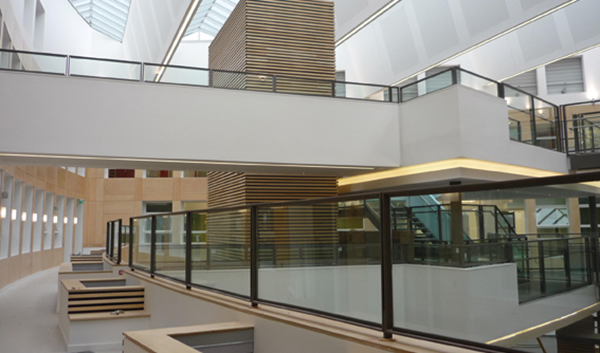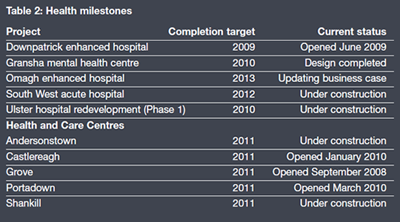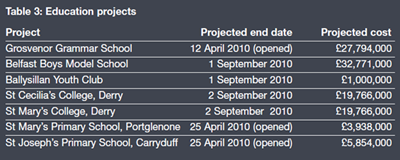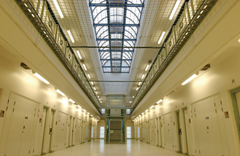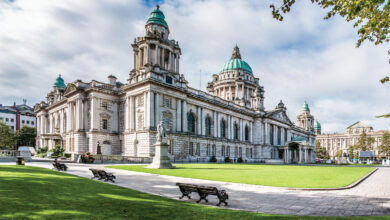Update
Two years into ISNI2, Northern Ireland’s residents are seeing the first fruits of its most extensive infrastructure programme, whether on the drive along the Westlink, waiting for treatment in the Downe Hospital or being taught in the redeveloped Grosvenor Grammar School, in east Belfast.
While most projects in the three key areas we have selected have been completed or are on target, delays have also crept up e.g. at the Gransha mental health centre outside Derry or the Ballee Road East dual carriageway outside Ballymena.
Fiscally, the Executive’s spending plans for 2010-2011 do see a drop in health and social care from £218.2 million to £201.7 million (down £16.5 million), while education decreases substantially from £201.1 million to £169.3 million (£31.8 million).
Only regional development sees a major boost, up £96.3 million from £459.9 million to £556.2 million, reflecting this strategy’s focus on economic development. Cuts from the Treasury will inevitably hit local budgets so the high expectations set out in 2008 may not be met by 2018.
Health
An 18 per cent reduction in the DHSSPS’ capital budget, from £728.5 million to £604 million, occurred after publication of the Investment Strategy. As a result, the department made “significant changes” to its ISNI targets.
It continues to strive towards the key milestones contained in the report. As Table 2 shows, all but one of these are on target. Procurement of the construction contract for the mental health crisis unit at Gransha hospital is to begin shortly with the new facility expected to be completed by 2012-2013. This is behind the ISNI target of 2010.
In relation to the enhanced hospital at Omagh, which is due to open in three years, “a number of issues” are currently being resolved by the department and the Western Trust on the updated business plan.
A DHSSPS spokeswoman said: “Only on approval of the business case and confirmation of the availability of funding to build and operate the new facility will an announcement on the way forward be made. The Minister has continually reaffirmed his commitment to this scheme.”
The double story car park at the new South West Hospital in Enniskillen is complete and work is taking place on construction of the superstructure of the main hospital building. In addition, the critical care complex at the Ulster Hospital is nearly complete.
The £14 million Beech Hall Health and Well-being Centre on the Andersonstown Road is currently under construction and is due to be completed in June this year. Similarly the £10 million Shankill Wellbeing and Treatment Centre is currently under construction and is due to finish in May 2011.
To date, seven new health and care centre facilities, out of 35, have been completed across the province. These are the Bradbury Centre, Holywood Arches Centre, Grove Well-being Centre, Carlisle Well-being Centre, Knockbreda Community Care and Treatment Centre, Kilkeel Primary Care Centre and Portadown Health and Care Centre.
Business cases are under way for four more health and care centres at Ballymena, Banbridge, Dunmurry and Lisnaskea.
In terms of IT investment, the department plans to spend £31 million on the Northern Ireland Picture Archiving and Communications System (NIPACS). It would enable diagnostic radiology images such as x-rays and scans to be stored and viewed electronically at any hospital site across the province.
Mental health services are another important area. “Investment in mental health is essential in ensuring the modernisation of Northern Ireland’s mental health services,” claimed the spokeswoman.
Examples of recent mental health care facilities are the £12 million Bluestone mental health crisis unit at Craigavon (opened in May 2008), the £9 million Beechcroft regional adolescent psychiatric unit at Forster Green (opened April 2010), the £7 million child and family psychiatric unit at Forster Green (due to open in May 2010), and the £4 million social education centre at Newry (planning to complete in 2010).
The economic downturn could affect the outcome of certain projects, as the spokeswoman explained: “Given the current financial climate and uncertainty surrounding the outcome of the next Comprehensive Spending Review, the department must look at all projects and be certain of the availability of funding.”
Education
A total of £3,510 million was allocated for schools and youth services over the whole period, breaking down into £718.0 million for 2008-2011 and £2,792 million for 2011-2018.
The Investment Strategy stated that eight special education needs schools would undergo major works within the 2008- 2018 bracket. Moira’s Brookefield Special School was completed in December 2008 and came in at a cost of £5.2 million; its original estimate was £2.9 million.
Seven other projects are at various stages of the planning process but department confirmed to agendaNi that each will have to be “considered against that department’s policy framework in light of the budget available”. In short, it is not known when the projects will be built or at what cost.
- Arvalee Special School, Omagh;
- Belmont Special School, Derry;
- Greenwood Assessment Centre, Belfast;
- Knockevin Special School, Downpatrick;
- Mitchell House Special School, Belfast;
- Rossmar Special School, Limavady;
- Torbank Special School, Dundonald.
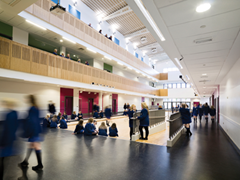 Projects which are currently on-site will be completed during the financial year. That includes seven PPP projects at the Belfast Boys’ Model, Grosvenor Grammar School, St Cecilia’s College, Derry, and St Mary’s College, Derry. St Joseph’s Primary School, Carryduff, and St Mary’s Primary School, Portglenone, will also benefit as well as Ballysillan Youth Club.
Projects which are currently on-site will be completed during the financial year. That includes seven PPP projects at the Belfast Boys’ Model, Grosvenor Grammar School, St Cecilia’s College, Derry, and St Mary’s College, Derry. St Joseph’s Primary School, Carryduff, and St Mary’s Primary School, Portglenone, will also benefit as well as Ballysillan Youth Club.
The public-private partnership (PPP) contracts for Grosvenor, Boys Model, Ballysillan Youth Club, St Cecilia’s College and St Mary’s College were signed before 1 April 2009 and will require £101 million of departmental funding. As a result of a change in PPP treatment after that date, both primary schools will not. There will, however, be a recurrent cost incurred by the department over the life of the contract.
Justice
Devolved to Northern Ireland after the Investment Strategy was published, justice capital projects are the responsibility of each agency, and are not handled centrally by the Department of Justice.
The Prison Service has two projects planned.
Magilligan prison will be redeveloped at a projected cost of £200 million and is anticipated to be completed between 2015 and 2020, depending on the procurement route.
Maghaberry will expand at a cost of £21 million to accommodate more prisoners. That project is planned to be completed by the spring of 2012.
The newly established Ireland Courts and Tribunals Service told agendaNi that it currently has no capital projects due to start or to be completed by 2018, in line with the Investment Strategy’s end date.
For the PSNI, the new public services training college in Cookstown is still in its planning stages but the Musgrave Street Police Station is underway while a new build station in Ballymoney is expected to begin later this year.
Transport
DRD figures show that £566.9 million has been spent in transport to date – i.e. 69.8 per cent of the 2008-2011 allocation. This breaks down into £366 million spent on roads by 31 March 2010 and £98.4 million on public transport, which does not include expenditure for this financial year, and the full £5.6 million sum for gateways i.e. ports.
agendaNi asked for progress on infrastructure projects which were to be completed by now and those planned for completion in the near future. Of the 10 to be completed by the close of 2009-2010, seven are now complete:
- A20 Frederick Street Link, Newtownards (November 2008);
- A4 Henry Street/Sligo Road extra lane, Enniskillen (December 2008);
- M1/Westlink upgrade, Belfast (March 2009);
- M2 widening (June 2009);
- A20 Newtownards Southern Distributor (July 2009);
- A4 and A5 improvements, Annaghilla and Tullyvar, near Ballygawley (February 2010);
- Four A1 junction improvements – Hillsborough, Dromore, Banbridge and Loughbrickland (all done by December 2009).
Two are still under construction:
- A29 Carland Bridge improvement – 1.3km realignment of single carriageway, bypassing the rural settlement of Carland between Dungannon and Cookstown;
- A26 and M2 Ballee Road East project – 1.5km of dual carriageway and two slip roads from the Seven Towers roundabout to Larne Road roundabout, Ballymena.
Advance ground consolidation works have taken place at the A32 Cherrymount Link in Enniskillen, to be followed by main works in 2011-2012. This involves 1.1km of single carriageway linking the Cherrymount roundabout to a new roundabout on the Temple Road.
Construction is continuing on the A1 Beech Hill to Cloghogue and A4 Dungannon to Ballygawley links, to be finished in 2010, and the A2 Broadbridge dualling, outside Derry, due in 2010-2011.
Two further projects were scheduled in the ISNI2 but are still at the development stage:
- A6-M22 dualling – 14km upgrade to dual carriageway from the end of the M22 outside Randalstown to Castledawson roundabout;
- A2 widening at Greenisland – 2.4km upgrade to four lanes from Jordanstown to Ravenhill.
Public inquiries have been held in both cases; the departmental statement has been published for A6-M22 and a notice of intention to proceed for the A2 widening.
Legislation for Belfast’s rapid transit is to be brought to the Assembly in June 2010 and the DRD hopes to appoint consultants later this year, to help prepare the outline business case. Its Rapid Transit Division is currently preparing layout drawings for the various route alignment options, to be published in early 2011.
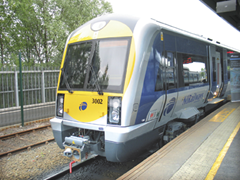 Improvements to public transport are on track including the procurement of the Phase 2 buses for Belfast’s Metro service (25 delivered in May 2008) and the Ballymena-to-Coleraine track life extension (completed in February 2010, ahead of the August 2010 deadline).
Improvements to public transport are on track including the procurement of the Phase 2 buses for Belfast’s Metro service (25 delivered in May 2008) and the Ballymena-to-Coleraine track life extension (completed in February 2010, ahead of the August 2010 deadline).
The contract award for a new train cleaning facility is being considered; it is due to be delivered by February 2011; the letter of offer was issued last August. A similar letter was issued in April for the platform extension programme, to be finished by June 2012.
£5.6 million was allocated for ‘gateways’ i.e. seaports and airports, in 2008-2009 but none beyond that financial year. Of this, £3.6 million went to two projects in Warrenpoint Harbour – a deep water quay and breakwater, and providing 7.5 metres of water depth for larger vessels. This was finished last June, just past the March 2009 deadline.
The remaining £2 million funded runway safety works at the City of Derry Airport. Most of these works were completed in March 2009 and the project will be finished up “within the next few months”; some navigational aids still need to be installed. Derry City Council also completed £9 million in additional safety works towards the end of 2009.
If plans proceed on schedule, the most visible and innovative part of the strategy in 2018 will be Belfast’s rapid transit system, although drivers west of the Bann look set to be its main beneficiaries. Roads will be widened or dualled in all four directions leading out from Derry. The A5 upgrade will cut journey times from the Maiden City to Dublin, while west-bound M1 motorists will continue on the A4 dual carriageway up to Ballygawley.
Travellers to the North Coast are to benefit from dual carriageways between Ballymoney and Coleraine, and along the Frosses Road outside Ballymena. A similar dualling on the A8 will mostly serve ferry passengers and lorry drivers to and from Larne. Bypasses and link roads projects are planned in Enniskillen, Armagh, Ballymena and Ballynahinch.
Sprucefield, meanwhile, will see a 4km bypass around the Sprucefield Park shopping centre, from the M1 to the A1 at Hillsborough.

